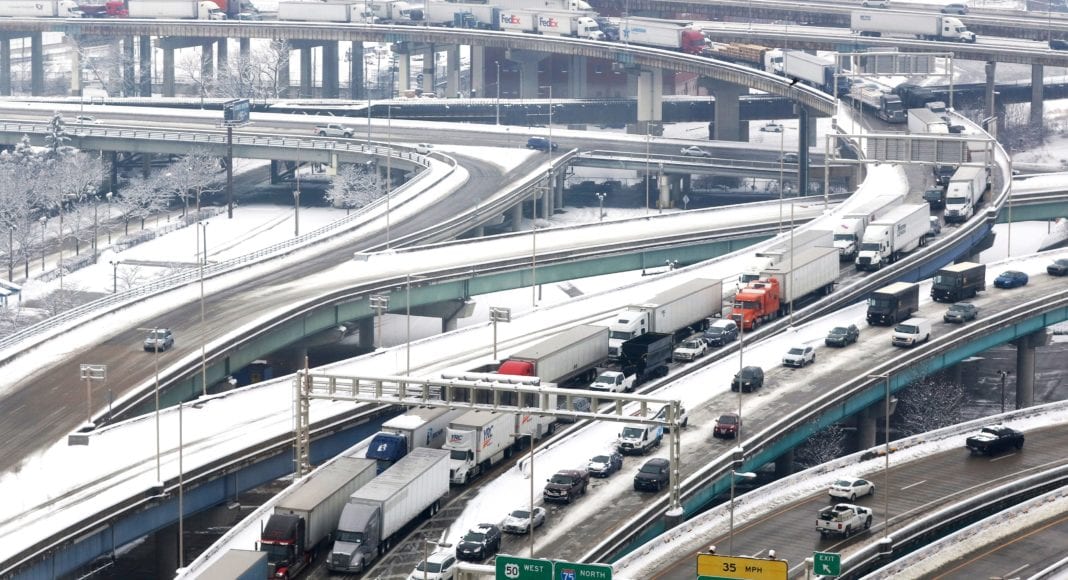(S&P Global Platts) Spot natural gas prices across much of the Western US surged to record highs in Feb. 12 trading as arctic weather fueled extreme localized demand, pushing supply and deliverability to their physical limit.
Hubs across the Midcontinent led the surge in prices again Feb. 12 as weather forecasts predicted the coldest temperatures in more than a decade would hit the region over the upcoming holiday weekend.
At locations across Kansas, Oklahoma and Eastern Arkansas, hub prices were trading at single-day record highs around $200 to $300/MMBtu. Regional hubs, which typically service only limited local demand, saw fierce competition among shippers, utilities and end-users looking to meet weekend requirements.
At one Enable Gas Transmission location, the cash market traded as high as $500 with weighted-average prices holding steady by mid-session around $359/MMBtu. At other nearby hubs, cash markets moved to dizzying, record highs with One Oak Oklahoma at $374, Southern Star at $275, Panhandle at $225 and ANR Oklahoma at $205. At the region’s benchmark location, NGPL Midcontinent, the market was holding around $205/MMBtu, data from the Intercontinental Exchange showed.
As end-users across the Midcontinent compete for available gas, shippers moved quickly to cut transmissions to neighboring markets. On Feb. 12 net, inbound shipments of gas climbed to 180 MMcf/d – their highest on record dating back to 2005. In January, the Midcontinent region – which typically delivers gas to neighboring markets – saw net outbound transmissions average nearly 3.1 Bcf/d, S&P Global Platts Analytics data shows.
At locations across much of the western and Midwestern US, prices also hit historic highs on Feb. 12.
West
Southern and Northern California spot gas prices saw a sharp divergence in Feb. 12 trading. At the SoCal Gas city-gate the cash market surged to $95.41/MMBtu while PG&E city-gates held at just $6.03/MMBtu.
Southern California, which gets much of its gas from the Permian Basin in West Texas and New Mexico, faced more exposure to the supply crunch in the Southwest and the Midcon. In Northern California, more consistent inflows from Canada and the Rockies, along with strong hydropower generation, have kept gas prices comparatively lower.
At the Permian’s benchmark Waha location, cash prices climbed to an all-time high of $158.52/MMBtu as weekend temperatures were forecast to fall into the single-digits Fahrenheit, Feb. 14-15. In addition to boosting demand, the colder weather could risk wellhead production freeze-offs.
Spot gas prices in the Rockies also smashed all-time records Feb. 12, with Cheyenne Hub soaring to $182.53/MMBtu and CIG, Rockies surging to $172.20/MMBtu. The sky-high Rockies gas prices reflect a fierce battle to keep supply in-region to service local demand as production plummets from freeze-offs.
Upper Midwest
Prices continued to spike in the Midcon market-area Feb. 12 with Chicago city-gates reaching an all-time high at $122/MMBtu and Natural Gas Pipeline-Nipsco hitting a record $203/MMBtu. MichCon and Consumers city-gates, however, held at $6.19/MMBtu and $10.57/MMBtu, respectively – still their highest prices since 2015.
Chicago temperatures were forecast to reach minus 3 F on Feb. 13 with one to four inches of snow in the forecast according to AccuWeather. Demand in the Upper Midwest was projected to reach 33.7 Bcf/d over the long holiday weekend – its highest level since 2019, according to Platts Analytics.
Southeast & Texas
Houston-area prices also reached all-time highs on Feb. 12, with Houston Ship Cannel rising to $182.04/MMBtu and Katy Hub hitting $127.52/MMBtu.
As Texas temperatures fall to an expected 39 degrees F below normal during the approaching weekend, statewide demand is forecast to top 24.6 Bcf/d by Feb. 15, up from 17.4 Bcf/d on Feb. 12.
While Houston spot gas prices skyrocketed, spot locations further east were unfazed and trading in the $5-$7/MMBtu range with cash Henry Hub at $6.00/MMBtu, up just 11.5 cents from the prior-day settlement. Through the upcoming weekend, production in the Southeast was forecast to remain fairly insulated from freeze-offs seen in the Permian, Midcontinent, and Rockies.
Northeast
Gas markets in the Northeast also remained largely insulated from the Feb. 12 price frenzy, shrugging off frigid temperatures. Prices stayed in the single digits across most indexes except Algonquin city-gates and Dracut, where cash markets slipped more than $1 on the day to reach $10.59/MMBtu and $12/MMBtu respectively.
Prices across all indexes in the Northeast and Appalachia came off significantly on the day with total demand in the region set to average about 36.7 Bcf/d, over the next four days – largely in line with levels seen over the past two weeks, Platts Analytics data showed.



